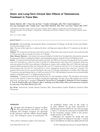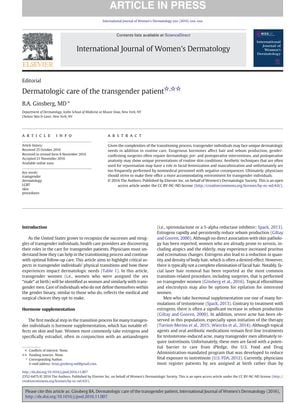TLDR Hormone therapy and surgeries for transgender individuals affect their skin and hair, requiring specific dermatologic treatments and respectful care.
The article from 2017 addressed the dermatologic needs of transgender individuals, focusing on the effects of hormone therapy and gender confirmation surgeries on skin and hair. It noted that estrogen in transgender women reduces sebum and body hair but does not eliminate facial hair, leading to the need for hair removal procedures. Testosterone in transgender men increases sebum production, potentially causing severe acne and male-pattern hair loss, with treatments including isotretinoin and topical minoxidil, while finasteride's use is controversial. The article also covered the dermatologic aspects of "top" and "bottom" surgeries, such as the need for preoperative hair removal and scar treatments. Noninvasive facial transformation procedures using neurotoxins and fillers were discussed, with a caution against nonmedical personnel performing these procedures. The importance of an inclusive and respectful dermatologic practice was emphasized, along with the need for dermatologists to manage complications from nonmedical procedures and to be cognizant of the higher rates of sexually transmitted infections among transgender women.
 110 citations
,
August 2016 in “Drugs”
110 citations
,
August 2016 in “Drugs” Minoxidil is the only FDA-approved topical drug for treating male or female pattern hair loss, and other medications like finasteride and dutasteride can also increase hair growth.
 110 citations
,
October 2013 in “The Journal of Sexual Medicine”
110 citations
,
October 2013 in “The Journal of Sexual Medicine” Testosterone treatment in trans men increases body and facial hair and may lead to hair loss over time, but severe skin issues are rare.
108 citations
,
February 2013 in “JAMA” Transgender treatment includes hormones and surgery, but long-term effects are unknown and counseling is needed.
 134 citations
,
June 2012 in “International Journal of Oral and Maxillofacial Surgery”
134 citations
,
June 2012 in “International Journal of Oral and Maxillofacial Surgery” Facial feminization surgery is effective in helping transgender women appear more feminine and has high patient satisfaction.
 176 citations
,
August 2000 in “The Journal of clinical endocrinology and metabolism/Journal of clinical endocrinology & metabolism”
176 citations
,
August 2000 in “The Journal of clinical endocrinology and metabolism/Journal of clinical endocrinology & metabolism” Hormone treatments in transsexual individuals reduce hair growth and oil production in male-to-females and increase them in female-to-males.
 1 citations
,
October 2022 in “Adolescent Health, Medicine and Therapeutics”
1 citations
,
October 2022 in “Adolescent Health, Medicine and Therapeutics” Gender-affirming therapy can cause skin issues like acne and hair loss in transgender adolescents, and more research is needed on its dermatological effects.
 146 citations
,
December 2016 in “Translational Andrology and Urology”
146 citations
,
December 2016 in “Translational Andrology and Urology” Hormone therapy is essential for transgender individuals but requires careful management due to possible metabolic effects.
 166 citations
,
October 2018 in “Endocrine Reviews”
166 citations
,
October 2018 in “Endocrine Reviews” Hormone treatments for transgender individuals generally improve mental health and physical transition, with some health risks that require medical supervision.
 22 citations
,
January 2015 in “The Cochrane library”
22 citations
,
January 2015 in “The Cochrane library” DHEA may help with sexual function when used intravaginally by menopausal women but is similar to hormone therapy in other aspects and might cause more side effects like acne and hair loss.
 21 citations
,
November 2014 in “Journal of Endocrinological Investigation”
21 citations
,
November 2014 in “Journal of Endocrinological Investigation” Cross-sex hormone therapy is important for managing gender dysphoria and requires careful monitoring and healthcare provider education.









